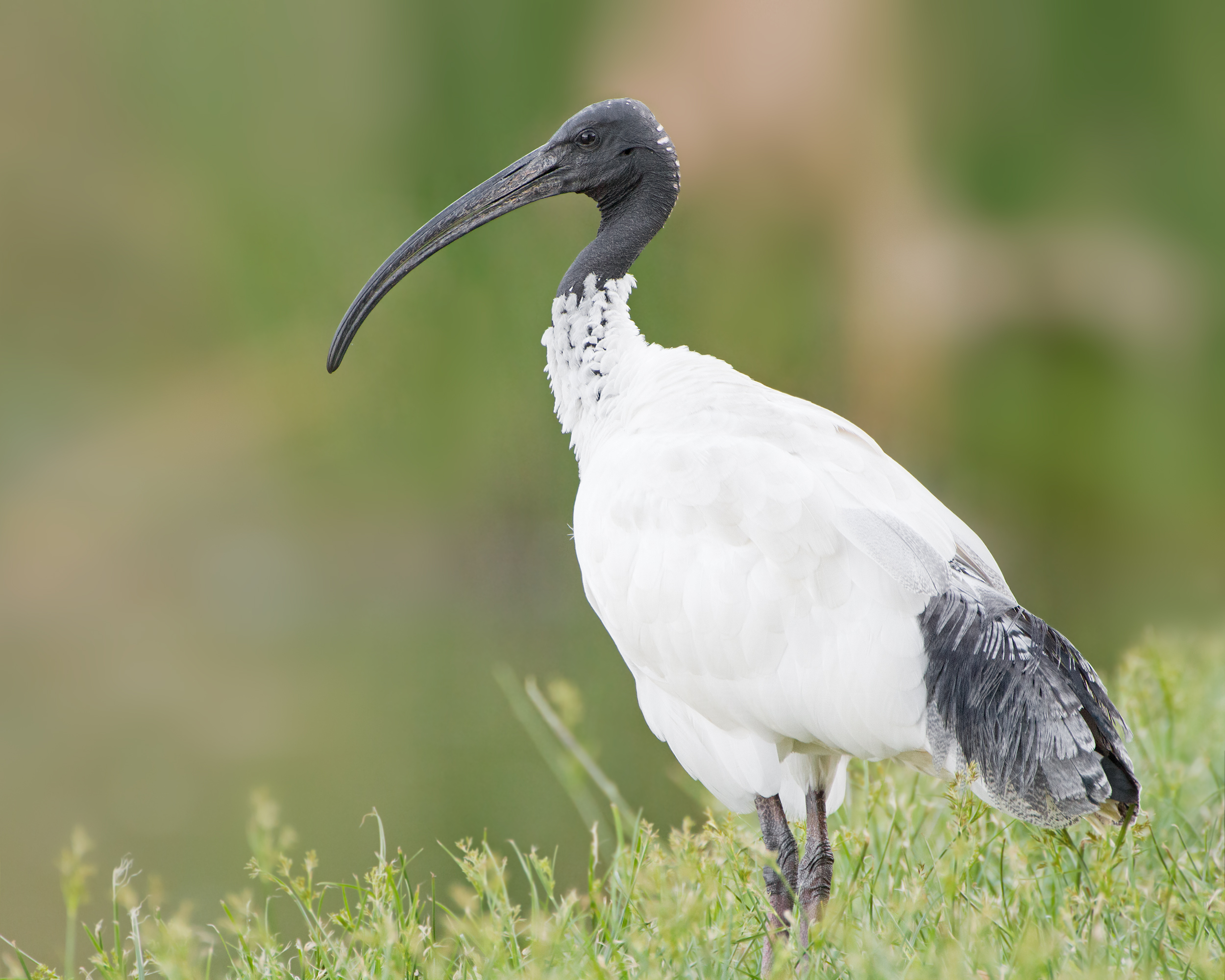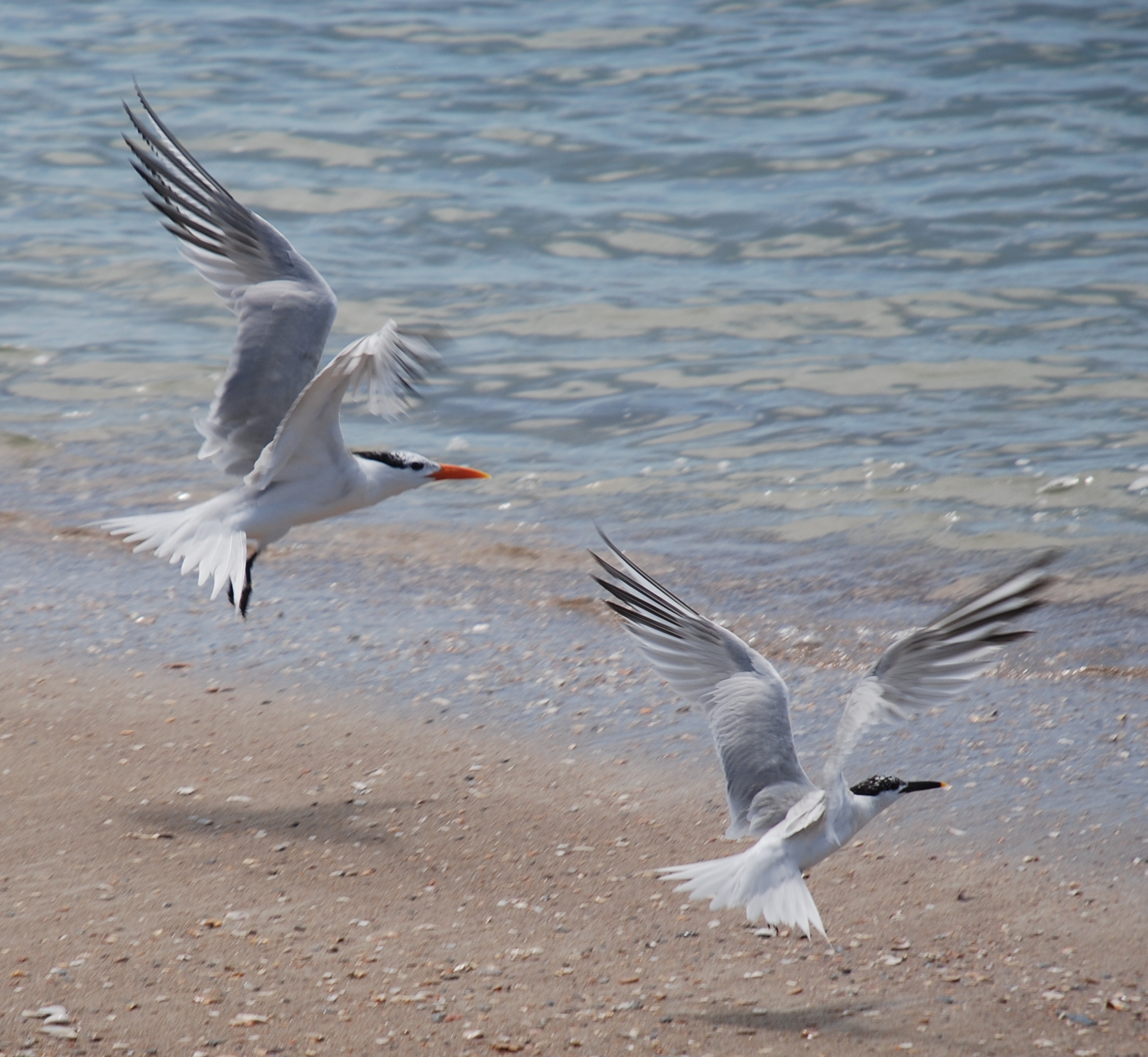|
Crested Tern
The greater crested tern Retrieved 28 February 2012 (''Thalasseus bergii''), also called crested tern or swift tern, is a tern in the family Laridae that nests in dense colonies on coastlines and islands in the tropical and subtropical Old World. Its five subspecies breed in the area from South Africa around the Indian Ocean to the central Pacific and Australia, all populations dispersing widely from the breeding range after nesting. This large tern is closely related to the royal and lesser crested terns, but can be distinguished by its size and bill colour. The greater crested tern has grey upperparts, white underparts, a yellow bill, and a shaggy black crest that recedes in winter. Its young have a distinctive appearance, with strongly patterned grey, brown and white plumage, and rely on their parents for food for several months after they have fledged. Like all members of the genus ''Thalasseus'', the greater crested tern feeds by plunge diving for fish, usually in marine en ... [...More Info...] [...Related Items...] OR: [Wikipedia] [Google] [Baidu] |
Chinese Crested Tern
The Chinese crested tern (''Thalasseus bernsteini'') is a tern in the family Laridae. It is the county bird of Lienchiang County, Fuchien. Description It is closely related to the Sandwich tern, ''T. sandvicensis'', and the lesser crested tern, ''T. bengalensis''. It is most similar to the former, differing only in the bill pattern, which is the reverse of the Sandwich tern's, being yellow with a black tip. From the lesser crested tern, which it overlaps in wintering distribution, it can be told by the white rump and paler grey mantle, as well as the black tip to the bill, which seen from up close also has a white point. The larger greater crested tern is also similar, differing in its stouter, all-yellow bill and darker grey mantle and rump, as well as in size. Distribution and conservation It is a critically endangered species, and previously thought extinct. Only four pairs were rediscovered in 2000 nesting in a greater crested tern colony on an islet in the Matsu Islands (a ... [...More Info...] [...Related Items...] OR: [Wikipedia] [Google] [Baidu] |
Lesser Crested Tern
The lesser crested tern (''Thalasseus bengalensis'')Bridge, E. S.; Jones, A. W. & Baker, A. J. (2005)A phylogenetic framework for the terns (Sternini) inferred from mtDNA sequences: implications for taxonomy and plumage evolution. ''Molecular Phylogenetics and Evolution'' 35: 459–469. is a tern in the family Laridae. Etymology The genus name is from Ancient Greek ''Thalasseus'', "fisherman" from ''thalassa'', "sea". The specific ''bengalensis'' means "of Bengal", the type locality, historically referring to much of northern India and Bangladesh. Distribution It breeds in subtropical coastal parts of the world mainly from the Red Sea across the Indian Ocean to the western Pacific, and Australia, with a significant population on the southern coast of the Mediterranean on two islands off the Libyan coast. Accidental breeding has also been reported in Italy and France. The Australian birds are probably sedentary, but other populations are migratory, wintering south to South Af ... [...More Info...] [...Related Items...] OR: [Wikipedia] [Google] [Baidu] |
Martin Lichtenstein
Martin Hinrich Carl Lichtenstein (10 January 1780 – 2 September 1857) was a German physician, explorer, botanist and zoologist. Biography Born in Hamburg, Lichtenstein was the son of Anton August Heinrich Lichtenstein. He studied medicine at Jena and Helmstedt. Between 1802 and 1806 he travelled in southern Africa, becoming the personal physician of the Governor of the Cape of Good Hope. In 1811 he published ''Reisen im südlichen Afrika : in den Jahren 1803, 1804, 1805, und 1806''; as a result, he was appointed professor of zoology at the University of Berlin in 1811, and appointed director of the Berlin Zoological Museum in 1813. In 1829, he was elected a foreign member of the Royal Swedish Academy of Sciences. He died after he had a stroke at sea travelling aboard a steamer from Korsør to Kiel. Legacy Lichtenstein was responsible for the creation of Berlin's Zoological Gardens in 1841, when he persuaded King Frederick William IV of Prussia to donate the ground ... [...More Info...] [...Related Items...] OR: [Wikipedia] [Google] [Baidu] |
Ibis
The ibises () (collective plural ibis; classical plurals ibides and ibes) are a group of long-legged wading birds in the family Threskiornithidae, that inhabit wetlands, forests and plains. "Ibis" derives from the Latin and Ancient Greek word for this group of birds. It also occurs in the scientific name of the cattle egret (''Bubulcus ibis'') mistakenly identified in 1757 as being the sacred ibis. Description Ibises all have long, downcurved bills, and usually feed as a group, probing mud for food items, usually crustaceans. They are monogamous and highly territorial while nesting and feeding. Most nest in trees, often with spoonbills or herons. All extant species are capable of flight, but two extinct genera were flightless, namely the kiwi-like ''Apteribis'' in the Hawaiian Islands, and the peculiar '' Xenicibis'' in Jamaica. The word ''ibis'' comes from Latin ''ibis'' from Greek ἶβις ''ibis'' from Egyptian ''hb'', ''hīb''. Beekes, R. S. P. (2009) ''Etymological Diction ... [...More Info...] [...Related Items...] OR: [Wikipedia] [Google] [Baidu] |
Conspecificity
Biological specificity is the tendency of a characteristic such as a behavior or a biochemical variation to occur in a particular species. Biochemist Linus Pauling stated that "Biological specificity is the set of characteristics of living organisms or constituents of living organisms of being special or doing something special. Each animal or plant species is special. It differs in some way from all other species...biological specificity is the major problem about understanding life." Biological specificity within ''Homo sapiens'' ''Homo sapiens'' has many characteristics that show the biological specificity in the form of behavior and morphological traits. Morphologically, humans have an enlarged cranial capacity and more gracile features in comparison to other hominins. The reduction of dentition is a feature that allows for the advantage of adaptability in diet and survival. As a species, humans are culture dependent and much of human survival relies on the culture and s ... [...More Info...] [...Related Items...] OR: [Wikipedia] [Google] [Baidu] |
Royal Tern
The royal tern (''Thalasseus maximus'') is a tern in the family Laridae. The species is endemic to the Americas, though strays have been identified in Europe.Buckley, P. A. and F. G. Buckley (2020). Royal Tern (Thalasseus maximus), version 1.0. In Birds of the World (S. M. Billerman, Editor). Cornell Lab of Ornithology, Ithaca, NY, USA. https://doi.org/10.2173/bow.royter1.01 Retrieved April 17, 2021 Taxonomy The royal tern was described by the French polymath Georges-Louis Leclerc, Comte de Buffon in 1781 in his ''Histoire Naturelle des Oiseaux'' from a specimen collected in Cayenne, French Guiana. The bird was also illustrated in a hand-coloured plate engraved by François-Nicolas Martinet in the ''Planches Enluminées D'Histoire Naturelle'' which was produced under the supervision of Edme-Louis Daubenton to accompany Buffon's text. Neither the plate caption nor Buffon's description included a scientific name but in 1783 the Dutch naturalist Pieter Boddaert coined the binomial ... [...More Info...] [...Related Items...] OR: [Wikipedia] [Google] [Baidu] |
Clade
A clade (), also known as a monophyletic group or natural group, is a group of organisms that are monophyletic – that is, composed of a common ancestor and all its lineal descendants – on a phylogenetic tree. Rather than the English term, the equivalent Latin term ''cladus'' (plural ''cladi'') is often used in taxonomical literature. The common ancestor may be an individual, a population, or a species (extinct or extant). Clades are nested, one in another, as each branch in turn splits into smaller branches. These splits reflect evolutionary history as populations diverged and evolved independently. Clades are termed monophyletic (Greek: "one clan") groups. Over the last few decades, the cladistic approach has revolutionized biological classification and revealed surprising evolutionary relationships among organisms. Increasingly, taxonomists try to avoid naming taxa that are not clades; that is, taxa that are not monophyletic. Some of the relationships between org ... [...More Info...] [...Related Items...] OR: [Wikipedia] [Google] [Baidu] |
Mitochondria
A mitochondrion (; ) is an organelle found in the cells of most Eukaryotes, such as animals, plants and fungi. Mitochondria have a double membrane structure and use aerobic respiration to generate adenosine triphosphate (ATP), which is used throughout the cell as a source of chemical energy. They were discovered by Albert von Kölliker in 1857 in the voluntary muscles of insects. The term ''mitochondrion'' was coined by Carl Benda in 1898. The mitochondrion is popularly nicknamed the "powerhouse of the cell", a phrase coined by Philip Siekevitz in a 1957 article of the same name. Some cells in some multicellular organisms lack mitochondria (for example, mature mammalian red blood cells). A large number of unicellular organisms, such as microsporidia, parabasalids and diplomonads, have reduced or transformed their mitochondria into other structures. One eukaryote, '' Monocercomonoides'', is known to have completely lost its mitochondria, and one multicellular orga ... [...More Info...] [...Related Items...] OR: [Wikipedia] [Google] [Baidu] |
Heinrich Boie
Heinrich Boie (4 May 1794, Meldorf, Holstein – 4 September 1827, Bogor, West Java, Indonesia) was a German zoologist. He was the brother of Friedrich Boie. In the field of herpetology they described 49 new species of reptiles and several new species of amphibians. Heinrich Boie studied law at Kiel and Göttingen. At university he became interested in natural history through the lectures of Johann Friedrich Blumenbach and Friedrich Tiedemann. He was appointed Coenraad Jacob Temminck's assistant at Leiden. In 1825 he travelled to Java with Salomon Müller in order to collect specimens for the museum. He died there of gall fever. A species of Indian gecko, '' Cnemaspis boiei'', is named in honor of Heinrich Boie or his brother Friedrich Boie.Beolens, Bo; Watkins, Michael; Grayson, Michael (2011). ''The Eponym Dictionary of Reptiles''. Baltimore: Johns Hopkins University Press. xiii + 296 pp. . ("Boie", p. 31). References Sources *Husson AM, Holthuis LB (1955). "The dates of ... [...More Info...] [...Related Items...] OR: [Wikipedia] [Google] [Baidu] |
Thalasseus
''Thalasseus'', the crested terns, is a genus of eight species of terns in the family Laridae. It has a worldwide distribution, and many of its species are abundant and well-known birds in their ranges. This genus had originally been created by Friedrich Boie in 1822, but had been abandoned until a 2005 study confirmed the need for a separate genus for the crested terns. These large terns breed in very dense colonies on coasts and islands, and exceptionally inland on suitable large freshwater lakes close to the coast. They nest in a ground scrape. ''Thalasseus'' terns feed by plunge-diving for fish, almost invariably from the sea. They usually dive directly, and not from the "stepped-hover" favoured by, for example, the Arctic tern. The offering of fish by the male to the female is part of the courtship display. These species have long thin sharp bills, usually a shade of yellow or orange except in the Sandwich tern and Cabot's tern where the bills are black with yellow tip ... [...More Info...] [...Related Items...] OR: [Wikipedia] [Google] [Baidu] |







